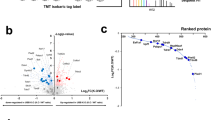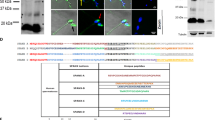Abstract
Uroplakins (UPKs) are specialized proteins that plan an important role in protecting the epithelium of the bladder from toxic waste. We recently demonstrated the expression pattern of UPKs in the male reproductive tract and their importance in sperm function in murine models. However, the exact mechanisms through which UPKs affect spermatogenesis are not reported. In this study, using yeast two-hybrid screening was conducted to determine the interaction partners of Uroplakin 1a (UPK1A). Y2H Gold yeast strain overexpressing UPK1A was mated with Y187 yeast strain overexpressing human testis cDNA library and the mutants were plated on SD agar plates containing selection media. Colonies that grew on SD/-Trp, SD/-Leu, SD/-His, and SD/-Ade plates were isolated and evaluated to identify the interacting partners of UPK1A. Regucalcin (RGN) and proteasome subunit beta 1 (PSMB1) were identified as potential interaction partners. Using HEK cells that overexpress UPK1A and RGN or PMSB1, the co-localization and interaction were estimated with high-resolution microscopy and Pearson’s coefficient. In light of the fact that UPK1A knockout caused subfertility and that the role of RGN and PSMB1 in spermatogenesis is documented, an interaction between UPK1A and RGN or PSMB1 could be required for spermatogenesis.


Similar content being viewed by others
Data Availability
All relevant data is available in the manuscript.
Code Availability
Not applicable.
References
Barh D, Yiannakopoulou EC, Salawu EO, Bhattacharjee A, Chowbina S, Nalluri JJ, Ghosh P, Azevedo V. In silico disease model: from simple networks to complex diseases. In Verma AS, Singh A (eds.) Animal Biotechnology (Second Edition). 2020;Academic Press:441–60. https://doi.org/10.1016/B978-0-12-811710-1.00020-3.
Kotlyar M, Pastrello C, Rossos A, Jurisica I. Protein–protein interaction databases. In Ranganathan S, Gribskov M, Nakai K, Schönbach C (eds.) Encyclopedia of Bioinformatics and Computational Biology. 2019;Academic Press:988–996. https://doi.org/10.1016/B978-0-12-809633-8.20495-0.
Kumar DT, Sneha P, Uppin J, Usha S, Doss CG. Investigating the influence of hotspot mutations in protein–protein interaction of IDH1 homodimer protein: a computational approach. Adv Protein Chem Struct Biol. 2018;11:243–61.
Hardcastle I. Protein–protein interaction inhibitors in cancer. In: Reference module in chemistry, molecular sciences and chemical engineering; 2016. https://doi.org/10.1016/B978-0-12-409547-2.12392-3.
Ansari-Pour N, Razaghi-Moghadam Z, Barneh F, Jafari M. Testis-specific Y-centric protein-protein interaction network provides clues to the etiology of severe spermatogenic Failure. J Proteome Res. 2016;15(3):1011–22. https://doi.org/10.1021/acs.jproteome.5b01080.
Schiza C, Korbakis D, Panteleli E, Jarvi K, Drabovich AP, Diamandis EP. Discovery of a human testis-specific protein complex TEX101-DPEP3 and selection of its disrupting antibodies. Mol Cell Proteomics. 2018;17(12):2480–95. https://doi.org/10.1074/mcp.RA118.000749.
Silva JV, Yoon S, Domingues S, et al. Amyloid precursor protein interaction network in human testis: sentinel proteins for male reproduction. BMC Bioinform. 2015;16(1):12. https://doi.org/10.1186/s12859-014-0432-9.
Petit FG, Kervarrec C, Jamin SP, et al. Combining RNA and protein profiling data with network interactions identifies genes associated with spermatogenesis in mouse and human. Biol Reprod. 2015;92(3):71. https://doi.org/10.1095/biolreprod.114.126250.
Adrina C, Fernanda MC, Gonzalez E, Lucrecia P, Jorge AB. Interaction of proteins of epididymal origin with spermatozoa. Biol Reprod. 1980;23(4):737–42. https://doi.org/10.1095/biolreprod23.4.737.
Björkgren I, Sipilä P. The impact of epididymal proteins on sperm function. Reprod. 2019;158(5):R155–r167. https://doi.org/10.1530/rep-18-0589.
Kant K, Tomar AK, Sharma P, Kundu B, Singh S, Yadav S. Human epididymis protein 4 quantification and interaction network analysis in seminal plasma. Protein Pept Lett. 2019;26(6):458–65. https://doi.org/10.2174/0929866526666190327124919.
Mariani NAP, Camara AC, Silva AAS, et al. Epididymal protease inhibitor (EPPIN) is a protein hub for seminal vesicle-secreted protein SVS2 binding in mouse spermatozoa. Mol Cell Endocrinol. 2020;506:110754. https://doi.org/10.1016/j.mce.2020.110754.
Hadziselimovic F, Verkauskas G, Stadler M. A novel role for CFTR interaction with LH and FGF in azoospermia and epididymal maldevelopment caused by cryptorchidism. Basic Clin Androl. 2022;32(1):10. https://doi.org/10.1186/s12610-022-00160-0.
Babu Munipalli S, Yenugu S. Uroplakin expression in the male reproductive tract of rat. Gen Comp Endocrinol. 2019;281:153–63. https://doi.org/10.1016/j.ygcen.2019.06.003.
Munipalli SB, Yenugu S. Uroplakin 1a knockout mice display marginal reduction in fecundity, decreased bacterial clearance capacity, and drastic changes in the testicular transcriptome. Reprod Sci. 2022;30(3):914–27. https://doi.org/10.1007/s43032-022-01057-z.
Darszon A, Nishigaki T, Beltran C, Treviño CL. Calcium channels in the development, maturation, and function of spermatozoa. Physiol Rev. 2011;91(4):1305–55. https://doi.org/10.1152/physrev.00028.2010.
Prabhu SM, Meistrich ML, McLaughlin EA, et al. Expression of c-Kit receptor mRNA and protein in the developing, adult and irradiated rodent testis. Reproduction. 2006;131(3):489–99. https://doi.org/10.1530/rep.1.00968.
Oduwole OO, Peltoketo H, Huhtaniemi IT. Role of follicle-stimulating hormone in spermatogenesis. Front Endocrinol. 2018;9:763. https://doi.org/10.3389/fendo.2018.00763.
Jégou A, Ziyyat A, Barraud-Lange V, et al. CD9 tetraspanin generates fusion competent sites on the egg membrane for mammalian fertilization. Proc Natl Acad Sci USA. 2011;108(27):10946–51. https://doi.org/10.1073/pnas.1017400108.
Yamaguchi M. The potential role of regucalcin in kidney cell regulation: involvement in renal failure (Review). Int J Mol Med. 2015;36(5):1191–9. https://doi.org/10.3892/ijmm.2015.2343.
Sharma S, Pei X, Xing F, et al. Regucalcin promotes dormancy of prostate cancer. Oncogene. 2021;40(5):1012–26. https://doi.org/10.1038/s41388-020-01565-9.
Laurentino SS, Correia S, Cavaco JE, et al. Regucalcin, a calcium-binding protein with a role in male reproduction? Mol Hum Reprod. 2012;18(4):161–70. https://doi.org/10.1093/molehr/gar075.
Pillai H, Shende AM, Parmar MS, et al. Regucalcin is widely distributed in the male reproductive tract and exerts a suppressive effect on in vitro sperm capacitation in the water buffalo (Bubalus bubalis). Mol Reprod Dev. 2017;84(3):212–21. https://doi.org/10.1002/mrd.22767.
Zhang Q, Ji SY, Busayavalasa K, Shao J, Yu C. Meiosis I progression in spermatogenesis requires a type of testis-specific 20S core proteasome. Nat Commun. 2019;10(1):3387. https://doi.org/10.1038/s41467-019-11346-y.
Zhang ZH, Jiang TX, Chen LB, et al. Proteasome subunit α4s is essential for formation of spermatoproteasomes and histone degradation during meiotic DNA repair in spermatocytes. J Biol Chem. 2021;296:100130. https://doi.org/10.1074/jbc.RA120.016485.
UniProt. UniProtKB - P20618 (PSB1_HUMAN): Proteasome subunit beta type-1. Accessed 26 June, 2022. https://www.uniprot.org/uniprot/P20618
Zhang N, Liang J, Tian Y, et al. A novel testis-specific GTPase serves as a link to proteasome biogenesis: functional characterization of RhoS/RSA-14-44 in spermatogenesis. Mol Biol Cell. 2010;21(24):4312–24. https://doi.org/10.1091/mbc.E10-04-0310.
Acknowledgements
SBM received junior and senior research fellowship from Government of India. We thank the facilities extended by UGC-SAP, UGC-CAS, DBT-CREBB, DST-PURSE, UGC-UPE-II, FIST, and IoE programmes at School of Life Sciences, University of Hyderabad. JA received the junior and senior research fellowship from Department of Biotechnology, Government of India.
Author information
Authors and Affiliations
Contributions
SBM carried out the experimental work. SY conceptualized the ideas, wrote the manuscript, and provided the reagents and other facilities.
Corresponding author
Ethics declarations
Ethics Approval
No animals were used in this study.
Consent to Participate
Not applicable.
Consent for Publication
All the authors have read the manuscript and consent to publish.
Competing Interests
The authors declare no competing interests.
Additional information
Publisher’s Note
Springer Nature remains neutral with regard to jurisdictional claims in published maps and institutional affiliations.
Rights and permissions
Springer Nature or its licensor (e.g. a society or other partner) holds exclusive rights to this article under a publishing agreement with the author(s) or other rightsholder(s); author self-archiving of the accepted manuscript version of this article is solely governed by the terms of such publishing agreement and applicable law.
About this article
Cite this article
Munipalli, S.B., Yenugu, S. Uroplakin 1a Interacts with Regucalcin and Proteasome Subunit Beta 1. Reprod. Sci. 30, 3520–3528 (2023). https://doi.org/10.1007/s43032-023-01292-y
Received:
Accepted:
Published:
Issue Date:
DOI: https://doi.org/10.1007/s43032-023-01292-y











